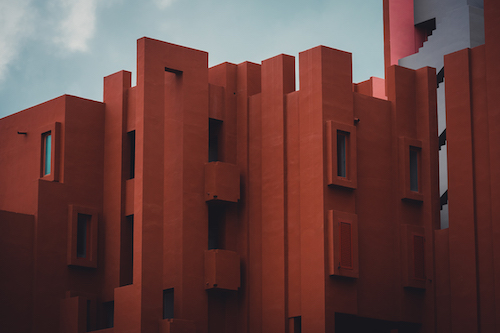Construction finishes, products, and components for commercial cladding give contractors and other professionals the ability to design beautiful buildings while helping keep them safe from the elements. With several exterior finishing options, you can make the best decision for the building in any environment. If you’re looking for exterior wall finishes for commercial buildings, but are unsure where to start, we’ll explore the importance of building finishes and which ones are typically used in construction.
What Is an Exterior Finish?
The kind of material used to cover a commercial building is known as an exterior finish. The exterior serves as the initial line of defense against the elements—particularly the sun, rain, snow, heat, and cold—to provide a more comfortable environment within. Beyond the protections offered, finishes also provide an aesthetic impact. A few examples of exterior wall finishing materials include brick, vinyl, stucco, fiber cement, and wood. The materials and techniques used in the external finishing process directly affect how long a building will survive. If improper materials and inferior installation are used, a building will succumb to regular wear and tear extremely quickly. For example, to stop rust and mold from developing and to increase the life span of the finish, a drainage and ventilation system between the siding and the wall is essential.

What Are Finishes IN CONSTRUCTION OF Exterior Walls?
When it comes to types of finishes in construction, there are several options to choose from. The four most commonly used finishes are stucco, vinyl, fiber cement, and brick.
Stucco
The exceptional durability and aesthetic adaptability of stucco make it an extremely popular material. In fact, stucco is the most common siding type for new single-family houses, according to the Census Bureau's Survey of Construction. Compared to wood or vinyl siding, stucco is significantly more fire-resistant since it is constructed of sand and cement, and on occasion, additional fibers, acrylic, or epoxy. Due to its porous nature, stucco absorbs moisture in humid environments. Therefore, severe humidity may rapidly degrade stucco siding if installation mistakes are made or regular maintenance is neglected. This is why integrating products like corner beads, casing beads, and metal lath are important for proper installation.
Vinyl
Vinyl siding has a wide range of aesthetic options, making it perfect for many commercial architectural styles. It is one of the most lightweight exterior wall materials, making it economical, accessible, and simple to install.
Vinyl is also quite simple to clean; a short power wash typically does the trick, which is useful in larger commercial settings. However, in extreme weather conditions, vinyl can be prone to cracking, warping, and brittleness.
Fiber Cement
Fiber cement is a non-combustible and very robust material made of cement, cellulose fibers, and sand. Fiber cement is extremely durable and needs very little upkeep throughout its lifetime, as it is not prone to rotting or warping. Due to its sustainability and utilization of recycled materials, fiber cement is also regarded as an environmentally-friendly finish. Due to its flexibility, it may be used to replicate shingles, stone, stucco, and a variety of other finish types. With the exception of real stone, fiber cement siding is significantly more expensive than many other building materials used in exterior finishing.
Brick or Brick Veneer
A wall with brick or brick veneer is linked to the exterior framing as an independent construction that does not structurally support the building. In addition to its visual appeal, brick is remarkably weatherproof, low-maintenance, energy-efficient, and ecologically beneficial. Additionally, it is resistant to fires, deterioration, and deformation brought on by extremes of heat or cold. Brick is considerably more expensive than vinyl, composite, and even wood siding. Moisture is still a problem and may quickly harm a brick building's frame if proper precautions are not taken at the time of installation.
A commercial building's exterior finish is its first line of defense against the environmental elements. Any popular finishing material, including stucco, vinyl, fiber cement, brick, wood, or stone, can be used to create the commercial exterior. Additional materials that might be utilized to complete a building's exterior include Sheetrock, metal siding, panel siding, longboard siding, wood panels, and sheet siding. The external finishing material selection and installation techniques have a direct impact on how long a structure will last. A structure will succumb to normal wear and tear very quickly if the wrong materials are used or the correct materials are not properly installed.
What Material Is Used for Exterior Walls?
Many of the installation and performance difficulties that affect exterior finishes have been addressed with a wide range of innovative solutions. In fact, a number of these creative approaches and technologies have been developed specifically to address the problems installers have when using conventional materials. These solutions relieve the burden placed on experienced, competent installers and make the training of inexperienced employees much more effective and efficient, allowing them to advance in installation proficiency more quickly.
ClarkDietrich offers several exterior finishing materials for you to choose from for your construction projects:
- Metal lath
- Corner beads
- Casing beads
- Starter strips
- Weep and sill screeds
- Control joints
- Expansion joints
- Reveals
- Rainscreen
The Easy Embedment System™ (EES) from ClarkDietrich offers a solid framework for lath embedment, resulting in tough, long-lasting exterior performance. Additionally, this approach was designed to make application simpler and to give inexperienced contractors the resources they need to successfully accomplish expert-level jobs. Because of our Structa Wire, E-Flange™ Casing Beads, and Control Joints offerings, EES provides embedment fully and effortlessly, with up to 80% more embedment over traditional materials. Visit our website to learn more about our finishing materials.